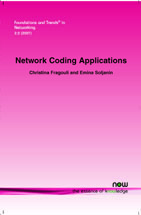Network Coding Applications
By Christina Fragouli, École Polytechnique Fédérale de Lausanne (EPFL), Switzerland, christina.fragouli@epfl.ch | Emina Soljanin, Bell Laboratories, USA, emina@research.bell-labs.com
Abstract
Network coding is an elegant and novel technique introduced at the turn of the millennium to improve network throughput and performance. It is expected to be a critical technology for networks of the future. This tutorial deals with wireless and content distribution networks, considered to be the most likely applications of network coding, and it also reviews emerging applications of network coding such as network monitoring and management. Multiple unicasts, security, networks with unreliable links, and quantum networks are also addressed. The preceding companion deals with theoretical foundations of network coding.
Network Coding Applications
Network Coding Applications looks at how ideas from network coding can have an impact on a number of new applications. Network coding is an elegant and novel technique introduced at the turn of the millennium to improve network throughput and performance. It is expected to be a critical technology for networks of the future. Today, more and more researchers and engineers ask what network coding is, what its benefits are, and how much it costs to design and operate networks implementing network coding. Network Coding Applications deals with wireless and content distribution networks, considered to be the most likely applications of network coding, and it also reviews emerging applications of network coding such as network monitoring and management. Multiple unicasts, security, networks with unreliable links, and quantum networks are also addressed. In tandem with the previous companion text on the theoretical foundations of network coding, Network Coding Applications provides the reader with a comprehensive state-of-the-art of this fast evolving research area.
